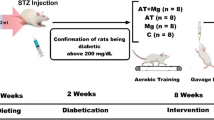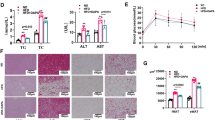Abstract
Visceral adipose fat has been claimed to be the link between obesity and insulin resistance through the released adipokines. This study aimed to assess the expression of vaspin as one of the recent adipokines in rats abdominal subcutaneous and visceral fat in diet-induced obese (DIO) and in DIO performing 3 weeks swimming exercise (DIO + EXE) compared to control and control + exercise (C + EXE) groups. Vaspin mRNA and protein expression assessed using RT-PCR and Western blotting analysis revealed vaspin expression in DIO and DIO + EXE but not in controls groups. In DIO group, visceral vaspin expression was higher than in that of subcutaneous fat and was positively correlated with body weight. Upregulation of visceral vaspin expression in DIO was concomitant with the development of insulin resistance (increase in fasting serum insulin and HOMA-IR) and rise in serum leptin level. Unchanged visceral vaspin mRNA in DIO + EXE rats, with significant improvements of insulin resistance parameters and serum leptin compared to DIO group was found. In conclusion, increased visceral vaspin expression in obesity was associated with insulin resistance. Further investigations into the molecular links between vaspin and obesity may unravel innovative therapeutic strategies in people affected by obesity-linked insulin resistance, metabolic syndrome, and type 2 diabetes.






Similar content being viewed by others
Abbreviations
- BMI:
-
Body mass index
- DIO:
-
Diet-induced obese
- EXE:
-
Exercise
- FFAs:
-
Free fatty acids
- HOMA-IR:
-
Homeostasis model assessment of insulin resistance
- IL:
-
Interleukin
- MCP-1:
-
Macrophage chemoattractant protein-1
- PAI-1:
-
Plasminogen-activated inhibitor-1
- ROS:
-
Reactive oxygen species
- rhVaspin:
-
Recombinant human vaspin
- Serpin:
-
Serine protease inhibitor
- SBP:
-
Systolic blood pressure
- TGs:
-
Triglycerides
- TNF-α:
-
Tumor necrosis factor-α
- Vaspin:
-
Visceral adipose tissue-derived serine protease inhibitor
- WATs:
-
White adipose tissues
References
James PT (2004) Obesity: the worldwide epidemic. Clin Dermatol 4:276–280
Carey V, Walters E, Colditz G (1997) Body fat distribution and risk of non-insulin-dependent diabetes in women. Am J Epidemiol 145:614–619
Seida A, Wada J, Kunitomi M, Tsuchiyama Y, Miyatake N, Fujii M et al (2003) Serum βFGF levels are reduced in Japanese overweight men and restored by a 6-month exercise education. Int J Obes Relat Metab Disord 27:1325–1331
Despres JP, Moorjani S, Lupien PJ, Tremblay A, Nadeau A, Bouchard C (1990) Regional distribution of body fat, plasma lipoproteins, and cardiovascular disease. Arteriosclerosis 10:497–511
Boden G (1997) Role of fatty acids in the pathogenesis of insulin resistance and NIDDM. Diabetes 46:3–10
Nielsen S, Guo ZK, Johnson CM, Hensrud DD, Jensen MD (2004) Splanchnic lipolysis in human obesity. J Clin Invest 113:1582–1588
Klein S (2004) The case of visceral fat: argument for the defense. J Clin Invest 113:1530–1532
Goodpaster BH (2005) Skeletal muscle lipid and its association with insulin resistance: what is the role for exercise? Exerc Sport Sci Rev 33:150–154
Calles-Escandon J, Goran MI, O’Connell M, Nair KS, Danforth E Jr (1996) Exercise increases fat oxidation at rest unrelated to changes in energy balance or lipolysis. Am J Physiol 270:E1009–E1014
Trayhurn P (2005) Endocrine and signaling role of adipose tissue: new perspectives on fat. Acta Physiol Scand 184:285–293
Zhang Y, Proenca R, Maffei M, Barone M, Leopold L, Friedman JM (1994) Positional cloning of the mouse obese gene and its human homologue. Nature 372:425–432
Scherer PE, Williams S, Fogliano M, Baldini G, Lodish HF (1995) A novel serum protein similar to C1q, produced exclusively in adipocytes. J Biol Chem 270:26746–26749
Samad F, Yamamoto K, Loskutoff DJ (1996) Distribution and regulation of plasminogen activator inhibitor-1 in murine adipose tissue in vivo. Induction by tumor necrosis factor-# and lipopolysaccharide. J Clin Invest 97:37–46
Steppan CM, Bailey ST, Bhat S, Brown EJ, Banerjee RR, Wright CM et al (2001) The hormone resistin links obesity to diabetes. Nature 409:307–312
Blüher M (2009) Adipose tissue dysfunction in obesity. Exp Clin Endocrinol Diabetes 117:241–250
Hida K, Wada J, Eguchi J, Zhang H, Baba M, Seida A et al (2005) Visceral adipose tissue-derived serine protease inhibitor: a unique insulin-sensitizing adipocytokine in obesity. Proc Natl Acad Sci USA 102:10610–10615
Klöting N, Kovacs P, Kern M, Heiker JT, Fasshauer M, Scho¨n MR et al (2011) Central vaspin administration acutely reduces food intake and has sustained blood glucose-lowering effects. Diabetologia 54:1819–1823
Körner A, Neef M, Friebe D, Erbs S, Kratzsch J, Dittrich K et al (2011) Vaspin is related to gender, puberty and deteriorating insulin sensitivity in children. Int J Obes (Lond) 35:578–586
Meyer-Hoffert U (2009) Reddish, scaly, and itchy: how proteases and their inhibitors contribute to inflammatory skin diseases. Arch Immunol Ther Exp 57:345–354
Klöting N, Berndt J, Kralisch S, Kovacs P, Fasshauer M, Schon MR et al (2006) Vaspin gene expression in human adipose tissue: association with obesity and type 2 diabetes. Biochem Biophys Res Commun 339:430–436
Youn BS, Klöting N, Kratzsch J, Lee N, Park JW, Song ES et al (2008) Serum vaspin concentrations in human obesity and type 2 diabetes. Diabetes 57:372–377
Wada J (2008) Vaspin: a novel serpin with insulin-sensitizing effects. Exp Opin Investig Drugs 17(3):327–333
Ward FW, Coates ME (1987) Dietary fat and N-nitrosation in the rat. Br J Nutr 58:221–231
Lajoie C, Calderone A, Trudeau F, Lavoie N, Massicotte G, Gagnon S et al (2004) Exercise training attenuated the PKB and GSK-3 dephosphorylation in the myocardium of ZDF rats. J Appl Physiol 96:1606–1612
Zhang QJ, Li QX, Zhang HF, Zhang KR, Guo WY, Wang HC et al (2007) Swim training sensitizes myocardial response to insulin: role of Akt-dependent eNOS activation. Cardiovasc Res 75(2):369–380
Dobrian A, Michael JD, Russell LP, Thomas JL (2000) Development of hypertension in a rat model of diet-induced obesity. Hypertension 35:1009–1019
Whittington KB, Solomon SS, Lu ZN, Selawry HP (1991) Islet allografts in the cryptorchid testes of spontaneously diabetic BB/Wor dp rats: response to glucose, glipizide, and arginine. Endocrinology 128:2671–2677
Axen KV, Dikeakos A, Sclafani A (2003) High dietary fat promotes syndrome X in non obese rats. J Nutr 133:2244–2249
Kekow J, Ulrichs K, Muller-Ruchholtz W, Gross WL (1988) Measurement of rat insulin-ELISA with increased sensitivity, high accuracy and greater practicability than established radioimmunoassay. Diabetes 37:321–326
Greenbaum CJ, Cuthbertson D, Krischer JP, Diabetes Prevention Trial of Type 1 Diabetes Study Group (2001) Type 1 diabetes manifested solely by 2-h oral glucose tolerance test criteria. Diabetes 50:470–476
Cruickshank JK, Heald AH, Anderson S, Cade JE, Sampayo J, Riste LK et al (2001) Epidemiology of the insulin-like growth factor system in three ethnic groups. Am J Epidemiol 154:504–513
Freeman NM, Walker S, Vrana K (1999) Quantitative RT-PCR: pitfalls and potential. Biotechniques 26:112–125
Morsi WG, Shaker OG, Ismail EF, Ahmed HH, El-Serafi TI, Maklady FA et al (2006) HO-1 and VGEF gene expression in human arteries with advanced atherosclerosis. Clin Biochem 39:1057–1062
Norusis M (1997) SPSS 7.5 Guide to data analysis, Simon and Schuster Company, Upper Saddle River, New Jersey
Bonora EF, Formentini G, Calcaterra F (2002) HOMA estimated insulin resistance is an independent predictor of cardiovascular disease in type 2 diabetic subjects: prospective data from the Verona diabetes study. Diabetes Care 25:1135–1141
Freedland ES (2004) Role of a critical visceral adipose tissue threshold (CVATT) in metabolic syndrome: implications for controlling dietary carbohydrates: a review. Nutr Metab 1:12–22
Linder K, Arner P, Flores-Morales A, Tollet-Egnell P (2004) Differentially expressed genes in visceral or subcutaneous adipose tissue of obese men and women. J Lipid Res 45:148–154
Van Harmelen V, Dicker A, Ryden M, Hauner H, Lonnqvist F, Naslund E et al (2002) Increased lipolysis and decreased leptin production by human omental as compared with subcutaneous preadipocytes. Diabetes 51:2029–2036
Lafontan M (2004) Fat cells: afferent and efferent messages define new approaches to treat obesity. Annu Rev Pharmacol Toxicol 45:119–146
Xu H, Barnes GT, Yang Q, Tan G, Yang D, Chou CJ et al (2003) Chronic inflammation in fat plays a crucial role in the development of obesity-related insulin resistance. J Clin Invest 112:1821–1830
Park KG, Park KS, Kim MJ, Kim HS, Suh YS, Ahn JD et al (2004) Relationship between serum adiponectin and leptin concentrations and body fat distribution. Diabetes Res Clin Pract 63:135–142
Trujillo ME, Scherer PE (2005) Adiponectin: journey from an adipocyte secretory protein to biomarker of the metabolic syndrome. J Intern Med 257:167–175
Blüher M (2012) Vaspin in obesity and diabetes: pathophysiological and clinical significance. Endocrine 41:176–182
Vera ER, Battell ML, Bhanot S, McNeill JH (2002) Effects of age and anesthetic on plasma glucose and insulin levels and insulin sensitivity in spontaneously hypertensive and Wistar rats. Can J Physiol Pharmacol 80:962–970
Lee KH, Ko BH, Paik JH, Jung KH, Choe YH, Choi Y et al (2005) Effects of anesthetic agents and fasting duration on 18F-FDG biodistribution and insulin levels in tumor-bearing mice. J Nucl Med 46:1531–1536
Johansen O, Vaaler S, Jorde R, Reikeras O (1994) Increased plasma glucose levels after Hypnorm anaesthesia, but not after pentobarbital anaesthesia in rats. Lab Anim 28:244–248
Pérez C, Fernández-Galaz C, Fernández-Agulló T, Arribas C, Andrés A, Ros M, Carrascosa JM et al (2004) Leptin impairs insulin signaling in rat adipocytes. Diabetes 53:347–353
Kamohara S, Burcelin R, Halaas JL, Friedman JM, Charron MJ (1997) Acute stimulation of glucose metabolism in mice by leptin treatment. Nature 389:374–377
Petersen KF, Oral EA, Dufour S, Befroy D, Ariyan C, Yu C et al (2002) Leptin reverses insulin resistance and hepatic steatosis in patients with severe lipodystrophy. J Clin Invest 109:1345–1350
Fukui M, Kitagawa Y, Nakamura N, Yoshikawa T (2002) Response to Öncül. Diabetes Care 25:1900–1901
Cohen B, Novick D, Rubinstein M (1996) Modulation of insulin activities by leptin. Science 274:1185–1188
Girard J (1997) Is leptin the link between obesity and insulin resistance? Diabetes Metab 23(Suppl 3):16–24
Pijl H, Toornvliet AC, Meinders AE (1996) Serum leptin in normal-weight and obese humans. N Engl J Med 334(23):1544 (Comment on N Engl J Med 334(5):292–295)
Chen H, Charlat O, Tartaglia LA, Woolf EA, Weng X, Ellis SJ et al (1996) Evidence that the diabetes gene encodes the leptin receptor: identification of a mutation in the leptin receptor gene in db/db mice. Cell 84:491–495
Kim SM, Cho GJ, Yannakoulia M, Hwang TG, Kim IH, Park EK et al (2011) Lifestyle modification increases circulating adiponectin concentrations but does not change vaspin concentrations. Metabolism 60:1294–1299
Bloem CJ, Chang AM (2008) Short-term exercise improves beta-cell function and insulin resistance in older people with impaired glucose tolerance. J Clin Endocrinol Metab 93:387–392
Skalicky J, Muzakova V, Kandar R, Meloun M, Rousar T, Palicka V (2008) Evaluation of oxidative stress and inflammation in obese adults with metabolic syndrome. Clin Chem Lab Med 46:499–505
Oberbach A, Kirsch K, Lehmann S, Schlichting N, Fasshauer M, Zarse K et al (2010) Serum vaspin concentrations are decreased after exercise-induced oxidative stress. Obes Facts 3:328–331
Acknowledgments
The authors gratefully acknowledge the financial assistance provided by the Faculty of Medicine, Cairo University.
Conflict of interest
The authors declared that there is no conflict of interest.
Author information
Authors and Affiliations
Corresponding author
Rights and permissions
About this article
Cite this article
Shaker, O.G., Sadik, N.A.H. Vaspin gene in rat adipose tissue: relation to obesity-induced insulin resistance. Mol Cell Biochem 373, 229–239 (2013). https://doi.org/10.1007/s11010-012-1494-5
Received:
Accepted:
Published:
Issue Date:
DOI: https://doi.org/10.1007/s11010-012-1494-5




